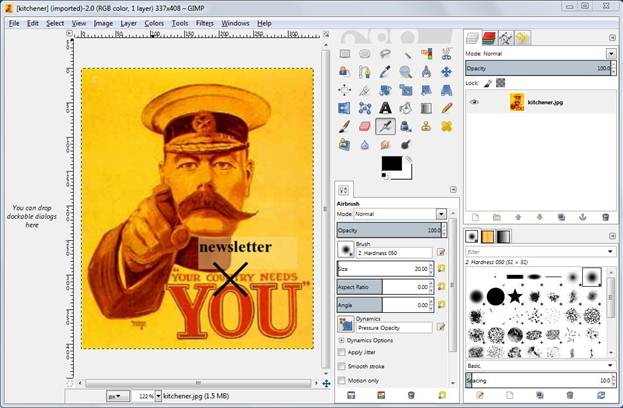|
|
Digital Image Editing with GIMP
by Alan German
Sure, you
could go wild and buy Adobe Photoshop CS6 for around $750
(or perhaps the Extended edition for more like $1050).
Or, maybe you would be satisfied with their baby brother,
Adobe Photoshop Elements, at around $100. Then again, you
could get most of the power, with none of the cost, by
trying GIMP - the GNU Image Manipulation Program.
Currently at Version 2.8, this open-source software, is
available for both Windows and Linux. Its current claim
to fame is that the program will run in a single window,
rather than the separate image window and floating tool
bars that were used previously. Of course, having the
program run in a single window isn't the default, and
making it do so isn't necessarily intuitive. While one
might think it would be necessary to find a setting under
Edit - Preferences, the "Single-window mode"
toggle is actually located under the Windows menu.

Once
enabled, the program window contains a display of the
current image being processed, various tool bars and, of
course, the main menu. There is an array of image
selection tools, a wide range of pencils and brushes, the
ability to add text in various fonts, dozens of image
filters, and many more options. While these provide a
bewildering range of features, some frequently-used image
editing items are readily implemented.
For example cropping an image is simply a matter of
clicking the mouse on the Rectangle Select Tool (the
rectangle icon in the top-left corner of the first tool
bar), then clicking on the image at a point marking the
top-left corner of the area to be cropped, holding the
mouse button down and dragging the cursor to the
bottom-right corner of the area to be cropped. The
selected area is now outlined by a rectangle. Making the
cut is as simple as selecting Image - Crop to Selection
from the main menu.
To adjust the brightness and contrast of an image, select
Colors - Brightness/Contrast from the main menu.
Adjusting the slider bars creates an instant preview of
the potential changes. Once you are satisfied, simply
press the OK button.
Red-eye removal may be even easier. From the main menu,
select Filters - Enhance - Red Eye Removal. It is quite
likely that the software will correctly identify - and
fix - the subject red eyes. Magic!
However, sometimes, the red-eye removal process doesn't
work too well automatically. One issue can be if the
young lady with the red eyes is wearing a red dress.
Automatic red-eye removal will fix the eyes, but will
also change the dress to black! As the dialogue box
states: "Manually selecting the eyes may improve the
results". So, it's clearly time for a little manual
processing. (It turns out all that is necessary is to
select each of the subject's red eyes in turn, using the
Ellipse Select Tool, before applying the red-eye removal
filter.)
Such usage details are readily available in GIMP's help
system. However, the user manual isn't part of a regular
download of GIMP. A language-specific (e.g. English)
version can be obtained in a separate download process.
But, this may not be necessary since, for most users, the
on-line manual is readily available over a high-speed
link, and the context of the help request leads directly
to the required information. And, the official
documentation isn't the only source of assistance. There
are many web sites that provide GIMP tutorials, tips and
tricks, and even video tutorials on YouTube to show you
how to do specific tasks.
I found one new program feature that I don't much like
when it came time to save my modified image. In the past,
this was as simple as File - Save; however, this option
now brings up a warning that the file can only be
"saved" in GIMP's native XCF file format. One
now has to use File - Export to save a JPG file as a JPG.
This isn't a show stopper, but for past users of the
program it is certainly a minor annoyance.
GIMP is an extremely powerful image editor, but using the
program can be as easy or as complex as you might wish.
The good news is that the software, being an open-source
product, is available at no cost. So, you can download
it, try it, and determine if GIMP fits your digital image
editing requirements.
Bottom Line:
GNU Image Manipulation Program (Open-Source)
Version 2.8
http://www.gimp.org/
Originally published: October, 2012
top of page
|
Archived Reviews
A-J
K-Q
R-Z
The opinions expressed in these reviews
do not necessarily represent the views of the
Ottawa PC Users' Group or its members.
|